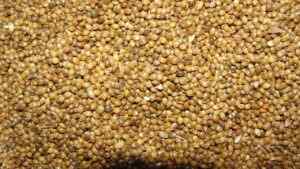Little millet is one of the healthiest foods you can taste. It boosts immunity and has exceptional nutritional values.
Little millet is, of course, gluten-free. If you want to take care of your health, little millet is an option you must regularly have on your kitchen table.
Little millet, botanically named Panicum sumatrense has various unofficial names around the world.
Yet in all the countries of our planet, one thing is the same. Health care certainly involves using this grocery. It’s mostly used in India and is suitable for all age groups.

Health Benefits Of Little Millet:
1. Packed with nutrients
As for nutritional values, little millet is a real health bomb. It’s rich in protein and fiber. It contains as much as 9.7 grams of protein and 7.6 grams of fiber per 100 grams.
It’s also a rich source of calcium and iron, which are excellent for your bones. Besides, iron helps prevent anemia and boosts your immune function.
However, it also contains 60.9 grams of carbohydrates per 100 grams. The wisdom is not to overdo anything. If you are on a diet, you’ll be interested to know that little millet contains 329 kcal per 100 grams.
Little millet provides the following nutrients per 100 grams (1):
- Calories: 329 kcal
- Protein: 9.7 grams
- Fat: 5.2 grams
- Ash: 5.4 grams
- Fiber: 7.6 grams
- Carbohydrate: 60.9 grams
- Calcium: 17 mg
- Iron: 9.3 mg
- Thiamine: 0.30 mg
- Riboflavin: 0.09 mg
- Niacin: 3.2 mg
2. May help fight against heart diseases
As for the diseases that can be treated with little millet, it’s no surprise that it can be a real ally in this field.
Cardiovascular diseases are today one of the leading causes of death in the world. According to one study, the use of little millet can reduce both LDL and total cholesterol levels (2), which may reduce the risk of heart diseases.
This should come as no surprise given that little millet contains components such as B-complex vitamins, essential amino acids, and important minerals.
3. May help fight diabetes
According to research, even little millet flakes have a moderate glycemic index of 52.11 (3).
This is important information given that foods with a lower glycemic index are very beneficial in the fight against diabetes. Therefore it would be wise to include them in your daily routine.
In another scientific study undertaken to develop a composite diabetic mix from regional millets, their benefit in treating this terrible disease was proven.
This mix seems to have a therapeutic effect, and it’s necessary to raise people’s awareness of the benefits of little millet (4).
4. Good for digestion
Little millet is rich in dietary fiber, which will speed up your digestion.
As fibers are not digestible, the body passes them out undigested. Additionally, fiber-rich foods may keep you full for longer and help control blood sugar levels.
If you feel tired, little millet is an excellent solution as it helps detoxify the body. All fitness freaks will guarantee for little millet. They know very well the benefits of this interesting food. You just need to use it regularly.
5. Rich in antioxidants
Research finds that edible forms of small millets are rich in antioxidants such as tocopherols, tocotrienols, and carotenoids (5).
Carotenoid
Carotenoids are important in human nutrition and health. They help prevent atherosclerosis and strengthen immune function. Also, carotenoids may improve eye health as they can be converted into Vitamin A.
Tocopherols & tocotrienols:
Tocopherols and tocotrienols are antioxidants, both of which have vitamin E activity.
Vitamin E functions as a natural antioxidant to protect fat in membranes around cells such as nerves, heart, muscles.
It also protects red blood cells from possible damage by oxygen and protects us from carcinogenesis, cardiovascular diseases, and aging.
You can prepare it like rice
It’s not difficult to assume that little millet is connected with other millets.
However, the difference is that the seeds of little millet are much smaller. It’s prepared similarly to rice.
We must note that it cooks much faster due to its smaller seeds than other millets. It’s beneficial if you are on a diet.
Side effects
To avoid side effects, don’t use it more than 3-4 times a week. It’s best to introduce it to your menu gradually. Once your digestive system gets used to the little millet, you’ll be able to eat it more often.
Although little millet has been used for centuries, it would be best not to eat it if you are prone to allergies. Also, it seems that people who have a thyroid problem should avoid millets.
Conclusion
Little millet is still a relatively unexplored food for most of the world. It’s used mostly in India, whose inhabitants have recognized its health and nutritional benefits.
With the expansion of the internet and the growing need for a healthy lifestyle, little millet is slowly finding its place in the kitchens worldwide. Therefore, be in trend, use little millet and stay healthy.